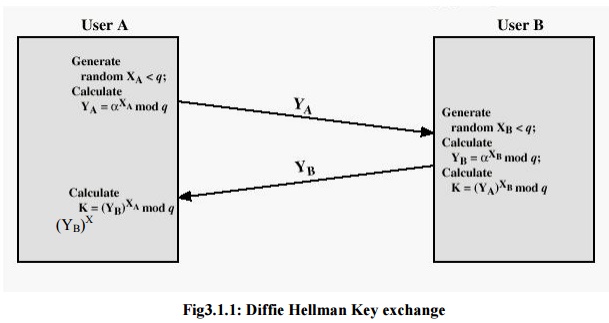Chapter: Cryptography and Network Security
Diffie-Hellman Key Exchange
DIFFIE-HELLMAN KEY EXCHANGE
The
purpose of the algorithm is to enable two users to exchange a key securely that
can then be used for subsequent encryption of messages.
The
Diffie-Hellman algorithm depends for its effectiveness on the difficulty of
computing discrete logarithms. First, we define a primitive root of a prime
number p as one whose power generate all the integers from 1 to (p-1) i.e., if
„a‟ is a primitive root of a prime number p, then the numbers a mod p, a2
mod p, … ap-1 mod p are distinct and consists of integers from 1 to
(p-1) in some permutation. For any integer „b‟ and a primitive root „a‟ of a
prime number „p‟, we can find a unique exponent „i‟ such that
b ≡ ai mod p, where 0 ≤
i ≤ (p-1)
The
exponent „i‟ is referred to as discrete logarithm. With this background, we can
define Diffie
Hellman
key exchange as follows:
There are
publicly known numbers: a prime number „q‟ and an integer α that is primitive
root of q. suppose users A and B wish to exchange a key. User A selects a
random integer XA < q and computes YA = α XA
mod q. Similarly, user B independently selects a random integer XB
< q and computes YB = α
XB mod q. Each side keeps the X value private
and makes the Y value available publicly to the
other
side. User A computes the key as K = (YB)XA mod q
and User
B computes the key as K = (YA)XB mod q
These two calculations produce identical results.
K = (YB)XA mod q
= (α XB
mod q)XA mod
q = (α XB)XA
mod q
= (α XA)XB
mod q
= (α XA
mod q)XB mod
q = (YA)XB
mod q
The
result is that two sides have exchanged a secret key.
The
security of the algorithm lies in the fact that, while it is relatively easy to
calculate exponentials modulo a prime, it is very difficult to calculate
discrete logarithms. For large primes, the latter task is considered
infeasible.

The
protocol depicted in figure is insecure against a man-in-the-middle attack. Suppose Alice and Bob wish to exchange
keys, and Darth is the adversary. The attack proceeds as follows:
Darth
prepares for the attack by generating two random private keys XD1
and XD2 and then computing the corresponding public keys YD1
and YD2.
Alice
transmits YA to Bob.
Darth
intercepts YA and transmits YD1 to Bob. Darth also calculates K2 = (YA)XD2
mod q.
Bob
receives YD1 and calculates K1 = (YD1)XE
mod q. 5. Bob transmits XA to Alice.
Darth
intercepts XA and transmits YD2 to Alice. Darth
calculates K1 =D1 mod q.
Alice
receives YD2 and calculates K2 = (YD2)XA
mod q.
At this
point, Bob and Alice think that they share a secret key, but instead Bob and
Darth share secret key K1 and Alice and Darth share secret key K2.
All
future communication between Bob and Alice is compromised in the following way:
Alice
sends an encrypted message M: E(K2, M).
Darth
intercepts the encrypted message and decrypts it, to recover M.
Darth
sends Bob E(K1, M) or E(K1, M'), where M' is any message. In the first case,
Darth simply wants to eavesdrop on the communication without altering it.
In the
second case, Darth wants to modify the message going to Bob. The key exchange
protocol is vulnerable to such an attack because it does not authenticate the
participants. This vulnerability can be overcome with the use of digital
signatures and public-key certificates.
Analog of Diffie-Hellman Key
Exchange
Key
exchange using elliptic curves can be done in the following manner. First pick
a large integer q, which is either a prime number p or an integer of the form 2m
and elliptic curve parameters a and b. This defines the elliptic group of points
Eq(a, b). Next, pick a base point G = (x1, y1)
in Ep(a, b) whose order is a very large value n. The order n of a
point G on an elliptic curve is the smallest positive integer n such that nG =
O. Eq(a, b) and G are parameters of the cryptosystem known to all
participants.
A selects
an integer nA less than n. This is A's private key. A then generates
a public key PA = nA x G; the public key is a point in
Eq(a, b).
B
similarly selects a private key nB and computes a public key PB.
A
generates the secret key K = nA x PB. B generates the
secret key K = nB x PA.
Related Topics